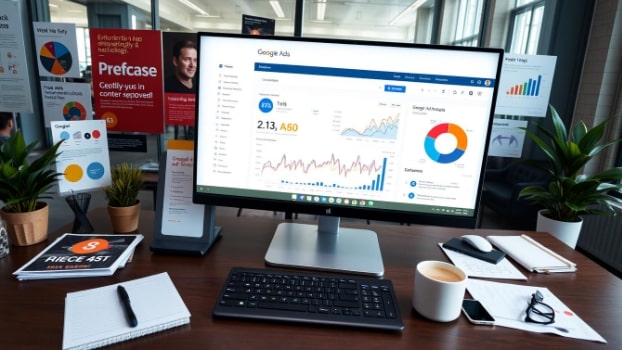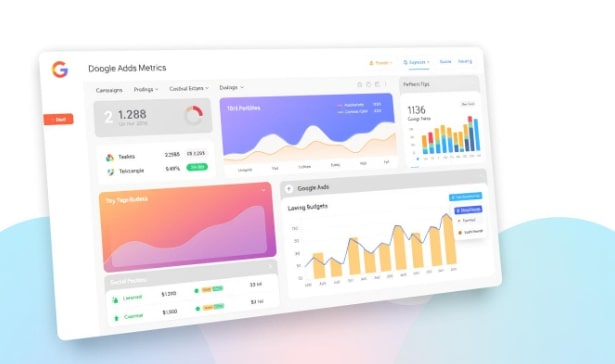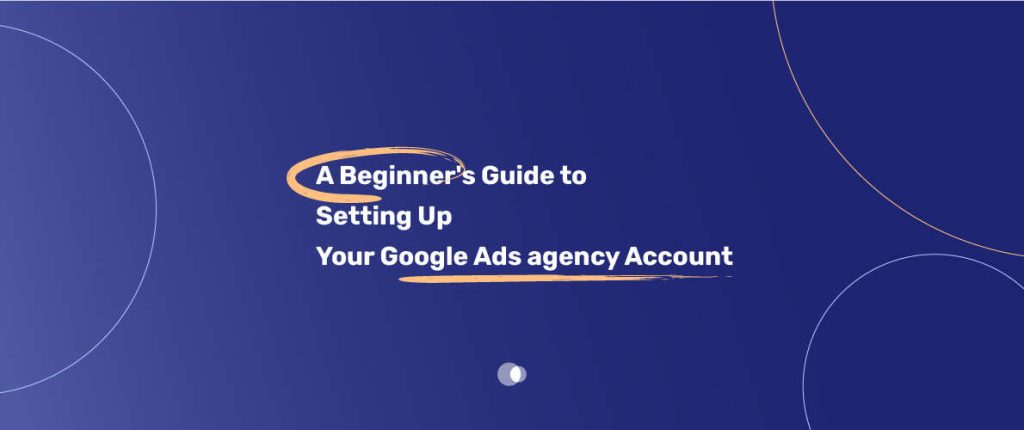Setting up a Google Ads agency account is key for any digital marketing agency. It helps manage many client accounts well. A good Google Ads agency account lets you manage campaigns, track performance, and improve ads for better results. This guide will show you how to set up your Google Ads agency account. We’ll cover the important steps and best practices to get you started.
Table of Contents

Having a Google Ads agency account is vital for agencies wanting to grow and deliver great results. By following this guide, you’ll learn to set up your Google Ads agency account. You’ll also know how to use the platform’s features well. This guide is for both new users and those looking to enhance their Google Ads setup. It aims to give you the knowledge and confidence to succeed.
Key Takeaways
- Setting up a Google Ads agency account is a critical step for digital marketing agencies
- A well-structured Google Ads agency account provides a centralized platform for managing campaigns and tracking performance
- Following a beginner’s guide can help you navigate the setup process and make the most out of Google Ads features
- Having a Google Ads agency account is essential for scaling operations and delivering exceptional results for clients
- This guide will cover the essential steps and best practices for setting up a Google Ads agency account
- By following this guide, you will gain the knowledge and confidence to succeed with your Google Ads agency account
Understanding Google Ads Agency Accounts Basics
Managing multiple Google Ads accounts needs a solid grasp of the basics. A Google Ads Manager Account lets agencies handle many client accounts from one place. This setup makes managing accounts easier, simplifies billing, and boosts reporting.
Key features of a Google Ads Manager Account include managing many client accounts and setting user permissions. Agencies can also track performance across all accounts. They can use automated reporting and budgeting tools to improve their clients’ campaigns.
- Centralized account management
- Simplified billing and invoicing
- Enhanced reporting and performance tracking
- Improved collaboration and communication with clients
Understanding AdWords agency account is key. Knowing the features and benefits helps agencies manage their clients’ accounts well. With a Google Ads Manager Account, agencies can focus on delivering great results for their clients.
| Feature | Description |
| Account Management | Manage multiple client accounts from a single interface |
| Reporting and Tracking | Track performance across all accounts and receive automated reports |
| User Permissions | Set up user permissions and access levels for clients and team members |
Prerequisites for Creating Your Agency Account
To start creating agency account with AdWords agency, you need to meet some requirements. These are key to a smooth setup and avoiding problems. Before you start, ensure you have the following:
You should know your business goals and have a basic Google Ads knowledge. Also, have a valid email and phone number for account verification. You’ll need to share some basic business details, like your business name and address.
- A valid Google account
- A clear understanding of your business goals and objectives
- Basic knowledge of Google Ads
- A valid email address and phone number
- Basic business information, such as business name and address
Meeting these requirements will help you successfullycreate agency account with Google Ads. You’ll be ready to begin your online advertising journey.
Setting Up Your Google Ads Agency Account
Setting up a Google Ads agency account is key to managing your clients’ online ads. First, you need to create a manager account. This account will be the main place for all your clients’ ads.
Creating Your Manager Account
To start, go to the Google Ads website and sign in with your Google account. Then, follow the steps to set up your manager account. This will give you tools to manage your clients’ ads better.
Configuring Basic Settings
After setting up your manager account, you’ll need to set some basic settings. This includes your agency’s name, address, and contact info. You also need to set up your billing and account settings to fit your needs.
Setting Up Security Protocols
To keep your clients’ accounts safe, you must set up security measures. This includes two-factor authentication and access controls. These steps help prevent unauthorized access and protect your clients’ sensitive info.
By following these steps, you can set up your Google Ads agency account. Start managing your clients’ online ads easily. Remember to take your time and set up everything carefully for a smooth process.
Establishing Your Agency’s Billing Structure
Managing your Google Ads agency account well means having a clear billing structure. This structure affects how you collect payments, track costs, and grow your revenue. To find the right billing structure, look at these options:
Understanding agency billing starts with knowing the payment models. You can pick from cost-per-click (CPC) or cost-per-thousand impressions (CPM). Each model has its own benefits and drawbacks. The right choice depends on your agency’s needs and goals. For example, a CPC model might work best for clients aiming to boost website traffic.
A well-organized billing structure is key for successful Google Ads campaigns. It helps you keep track of expenses, manage client payments, and boost your agency’s earnings. Here are the main advantages of a clear billing structure:
- Improved financial management
- Enhanced client relationships
- Increased revenue optimization
By setting up a good billing structure for your Google Ads agency, you’ll manage finances better, strengthen client ties, and increase earnings. Always check and tweak your billing structure to fit your agency’s changing needs.
Managing Client Access and Permissions
Managing client access and permissions is key to keeping your agency’s accounts safe and sound. You need to set up user roles, control access levels, and talk clearly with your clients.
It’s important to know the different levels of access and permissions, like view-only and edit. This lets you give the right access to your clients. They can see how their account is doing without risking your agency’s security.
User Role Hierarchies
User role hierarchies are crucial for managing access and permissions. A clear hierarchy ensures each user has the right level of access, from basic to admin. This stops unauthorized access and keeps your agency’s accounts safe.
Access Level Configuration
Setting up access levels is another big part of managing client access and permissions. You create levels like client, manager, and administrator, each with its own permissions. This way, users can do their jobs without risking your agency’s security.
| Access Level | Permissions |
| Client | View-only |
| Manager | Edit and view |
| Administrator | Full access |
With a strong client access and permissions system, you keep your agency’s accounts safe. You also let your clients see how their account is doing.
Organizing Your Agency Dashboard
To get the most out of your Google Ads experience, it’s key to have a well-organized agency dashboard. This is where you manage all client accounts, track performance, and make smart decisions. A messy dashboard can slow you down and make work harder.
A good agency dashboard focuses on the most important tasks and features. It should be easy to navigate and find what you need fast. You can customize it to fit your needs by creating sections for different clients or campaigns.
Here are some tips to help you organize your agency dashboard:
- Customize the layout to suit your workflow
- Prioritize tasks and features based on importance and urgency
- Use labels and filters to categorize and prioritize tasks
- Set up regular performance tracking and reporting
By following these tips and setting up your agency dashboard right, you’ll work more efficiently. You’ll get the most out of your Google Ads. Always check and update your dashboard to keep up with your changing needs and goals.

Linking Client Accounts to Your Agency Profile
To manage many client accounts well, linking them to your agency profile is key. This makes managing and reporting easier. You can then focus on giving top-notch service to your clients. The linking process is simple, and once done, you can manage all accounts from one place.
When you link client accounts, make sure each one is set up right. This means checking client details, setting up billing, and making sure you can talk to them easily. This way, you can offer personalized help to each client while keeping your agency organized.
Account Linking Process
The account linking process has a few main steps:
- Getting client account info and checking it
- Creating client accounts in your agency profile
- Setting up how you’ll bill and get paid from each client
- Creating ways to talk and share info with clients
By following these steps, you can link accounts smoothly and manage them easily.
Troubleshooting Common Issues
Sometimes, problems can come up when linking accounts. Issues like wrong client info, billing mistakes, or not being able to talk can happen. To fix these, knowing the linking process well and talking openly with clients is crucial.
Setting Up Performance Tracking
Performance tracking is key for managing a Google Ads agency account. It helps agencies see how well their campaigns are doing. This way, they can make smart choices to improve their strategies.
Agencies can use the performance tracking tools in their Google Ads account. They can set up tracking codes like conversion tracking and remarketing tags. This helps them keep an eye on how their campaigns are doing. They can also use third-party tools to get even more insights.
Some good things about performance tracking for Google Ads agency accounts include:
- Improved campaign optimization
- Enhanced decision-making
- Increased return on ad spend
By using performance tracking, agencies can make their Google Ads strategies better. This leads to better results for their clients. As a Google Ads agency, focusing on performance tracking is crucial for campaign success and agency growth.
Implementing Agency-Level Reporting
Agency-level reporting is key for managing many client accounts. It helps agencies make smart decisions, improve campaigns, and boost performance. To start, create report templates that fit your needs. These should include important metrics like click-through rates and return on ad spend.
Using automated reporting can make things easier. It lets you schedule reports, send alerts, and build custom dashboards. This way, you save time for more important tasks like planning and optimizing.
Benefits of Agency-Level Reporting
- Improved data visibility and insights
- Enhanced decision-making capabilities
- Increased efficiency and productivity
- Better client management and communication
With agency-level reporting, you understand your clients better. This leads to smarter decisions and growth. The right templates and tools help you reach your goals.

Customizing Your Reporting Dashboard
A good reporting dashboard is vital. Customize it with important metrics like campaign and client performance. This creates a central place for all your data needs, making decisions easier.
| Reporting Metric | Description |
| Campaign Performance | Track key metrics, such as click-through rates and conversion rates |
| Client Metrics | Monitor client-specific metrics, such as return on ad spend and customer acquisition cost |
| Team Performance | Evaluate team performance, including metrics such as response time and resolution rate |
Agency Account Security Best Practices
To keep your agency account safe, it’s key to follow best practices. Agency account security helps stop unauthorized access. It also keeps your Google Ads campaigns safe and sound.
Here are some tips to help you:
- Use strong, unique passwords for all users and update them regularly
- Implement access control measures, such as two-factor authentication, to prevent unauthorized access
- Regularly audit your account activity to detect and respond to potential security threats
By sticking to these tips, you can protect your agency account. This is very important when using Google Ads. It needs access to sensitive client data.
Remember, agency account security is a constant job. It needs regular checks and upkeep. By focusing on security and following best practices, you can lower the risk of breaches. This helps your Google Ads campaigns succeed.
Scaling Your Agency Account Structure
As your agency grows, having a scalable account structure is key. It supports client growth and expansion. You need to plan for the future and meet your clients’ needs.
Here are important factors to consider:
- Regularly review and assess your current agency account structure to identify areas for improvement.
- Develop a strategy for scaling your account structure to accommodate new clients and growing demands.
- Implement a flexible and adaptable approach to managing your agency account, allowing for easy adjustments as needed.
By focusing on agency account structure and planning for growth, your agency will be ready for challenges and opportunities. This will help you offer better services and stay competitive.
A well-planned and scalable agency account structure is vital for your agency’s long-term success. By focusing on scaling, agency account structure, and client growth, you can ensure your agency’s continued growth and development.
| Agency Account Structure | Scaling | Client Growth |
| Flexible and adaptable approach | Regular review and assessment | Anticipating client needs |
| Easy adjustments and modifications | Developing a growth strategy | Providing better services |
Conclusion
Setting up a Google Ads agency account is key for agencies to manage ads well. Knowing the basics, setting up billing right, and securing accounts are essential. These steps lay a strong base for your agency’s success.
The Rent Google Ads agency account offers many features to improve your work. It helps you communicate better with clients and boosts campaign results. Always keep your account safe, check your growth plan often, and update your Google Ads agency account to grow your business.
This guide gives you the confidence to start and manage a Google Ads agency account successfully. By following best practices and keeping up with updates, you’ll deliver great results. This will help your agency grow and stand out in digital marketing.
FAQ
What is a Google Ads Manager Account?
A Google Ads Manager Account lets agencies and advertisers manage many Google Ads accounts in one place.
What are the benefits of an agency account structure?
An agency account structure helps manage clients better. It also makes reporting easier and gives more control over who can access what.
What are the key features for agencies in Google Ads?
Agencies in Google Ads have features like user roles, custom dashboards, and automated reports.
What are the prerequisites for creating a Google Ads agency account?
To create a Google Ads agency account, you need a Google account. You must also understand the agency-client relationship and have all the client information needed.
How do I create a Google Ads Manager Account?
To create a Google Ads Manager Account, sign in to your Google account. Then, go to the Google Ads platform and choose “Create Manager Account” from the menu.
How do I configure the basic settings for my agency account?
To set up your agency account, you need to add payment methods, time zones, and other preferences. This ensures everything runs smoothly.
What security protocols should I set up for my agency account?
For your agency account’s security, use two-factor authentication, control user access, and do regular security checks. This protects client data.
How do I establish my agency’s billing structure?
To set up your agency’s billing, choose the right billing model, add payment methods, and talk clearly with clients about fees.
How do I manage client access and permissions in my agency account?
To manage client access, set up user roles, control access levels, and customize how you communicate with clients. This keeps things secure and under control.
What are some tips for organizing my agency dashboard?
To organize your agency dashboard, customize the layout, focus on important tasks, and make workflows more efficient. This boosts productivity and efficiency.
How do I link client accounts to my agency profile?
To link client accounts, go through the account linking process, solve common problems, and manage many client accounts well.
How do I set up performance tracking for my agency account?
To track performance, add tracking codes, watch how campaigns do, and analyze results. This helps improve your campaigns.
How do I implement agency-level reporting?
For agency-level reporting, create report templates, use automated reports, and set up a custom dashboard. This gives clients detailed insights.
What are the best practices for agency account security?
For agency account security, manage passwords, control access, and do regular security checks. This keeps client data safe.
How do I scale my agency account structure?
To grow your agency account, add new clients, manage growth, and use resources well. This helps as your client base grows.



